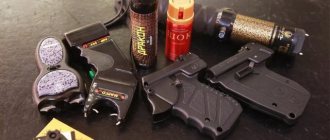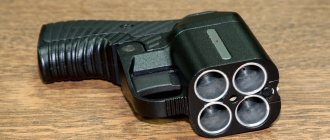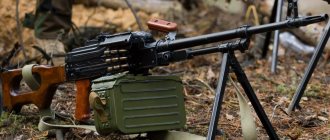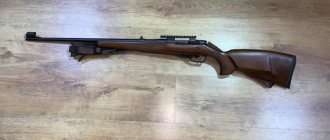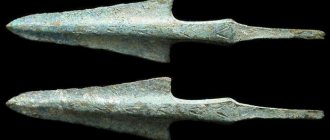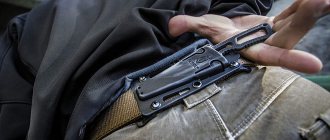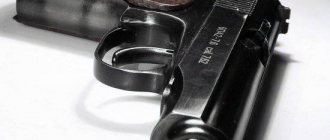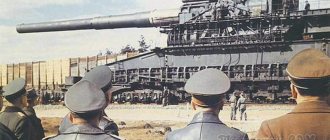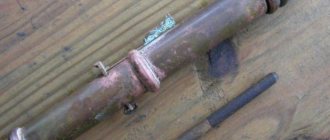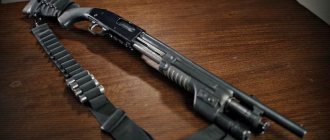Home | Weapons | Assault rifles | Russia / USSR | Kalashnikov assault rifle AK-74 / AKS-74
Kalashnikov AK-74 assault rifle
Kalashnikov AKS-74 assault rifle with folded stock
AK-74 with a GP-25 grenade launcher. Photo (c) KardeN
Automatic carbine AK-74 (GRAU Index - 6P20) 5.45 mm caliber, developed in 1970 by designer M.T. Kalashnikov, was adopted by the USSR armed forces in 1974. It is a further development of the AKM.
In the 1970s, following the NATO countries, the USSR followed the path of transferring small arms to low-impulse cartridges with reduced-caliber bullets to lighten the wearable ammunition (for 8 magazines, a 5.45 mm caliber cartridge saves 1.4 kg) and reduces , was considered to have “excessive” power of the 7.62 mm cartridge. In 1974, a weapon complex chambered for 5.45×39 mm was adopted, consisting of an AK-74 and an RPK-74 light machine gun, and subsequently (1979) supplemented by the small-sized AKS-74U, created for use in a niche that Western armies were occupied by submachine guns, and in recent years by the so-called PDW.
Main differences from its predecessor
- a new cartridge of 5.45×39 mm caliber (instead of 7.62×39 mm), which has a flatter bullet trajectory, which led to an increase in the direct shot range by 100 meters, and is also lighter (weight savings of 1.4 kg when carried ammunition in 8 magazines);
- a new muzzle brake-compensator, which serves to increase combat accuracy and reduce recoil energy;
- The magazine is made of light and durable plastic.
For assault rifles produced in 1974-1986, the butt and fore-end are made of wood. Since 1986, they began to be made from black plastic. Longitudinal grooves were made on the wooden butt on both sides to lighten the overall weight of the machine gun. They continue to be made on plastic stocks.
Can be used with the GP-25 or GP-30 or GP-34 underbarrel grenade launcher.
The accuracy of automatic fire has improved almost 2 times compared to the AKM (in linear dimensions). The accuracy of a single fire is approximately 50%.
The effective firing range of the AK 74 is:
For single ground and air targets - 500 meters;
For ground group targets - 1000 meters.
Direct shot range:
- According to the chest figure - 440 meters;
- His height is 625 meters.
AK-47 design
Unlike the Simonov self-loading carbine, which also fired an intermediate cartridge with a caliber of 7.62x39 mm, the design of the Kalashnikov assault rifle looks much simpler. This is evidenced by product drawings and complete disassembly of the AK-47 down to the smallest detail. From an operational point of view, the automatic carbine created by Kalashnikov was more convenient and efficient. The army, navy and Border Troops quickly appreciated the combat capabilities of the new weapon, which combined the accuracy of a rifle and the rate of fire of a machine gun.
Serial production of the AK-47 began at the Izhevsk Mechanical Plant, which later became the main domain of Soviet automatic small arms. A little later, Kalashnikov assault rifles began to be produced at another of the country's oldest arms enterprises - the Tula Arms Plant. In total, up to 15 million units of this weapon and its various modifications were manufactured at factories in Izhevsk and Tula, until the AKM, a modernized Kalashnikov assault rifle, began to enter service in 1959.
During the production process, the design of the product was constantly improved, but the general and main components and mechanisms of the machine remained unchanged. The operating principle of automatic weapons, which are based on the action of powder gases, also remained unchanged. As a result of the shot, powder gases through the side holes in the barrel act on the gas piston, which moves the bolt frame. The bolt frame, moved to the required distance, is ready to receive the next cartridge, after which the barrel bore is locked by turning the bolt.
The bolt is driven due to the presence of a bevel of the bolt frame. In his weapon, Kalashnikov made the bolt frame the main element of automation. With its help, the entire direction of movement of the moving parts is set; the bolt frame bears the main mechanical load. In turn, inside the bolt frame there is a return spring, which returns the entire mechanism to its original, firing position. The principle of operation of the automation that Kalashnikov used in his automatic rifle was known earlier, but it was the Soviet designer who managed to bring this system to perfection. As a result, all subsequent modifications of the AK are considered the most trouble-free weapon. It should be noted that, unlike foreign systems, the moving parts of the Kalashnikov assault rifle have fairly decent tolerances. This, in turn, reduces the risk of jamming and jamming of the weapon during shooting in conditions of increased contamination.
Combat cocking is carried out using a handle, which is a single structure with the bolt frame. After the shot, the cartridge case is extracted through a window in the receiver. The presence of a spring-loaded ejector and reflector on the receiver allows the cartridges to fly out in a certain direction without interfering with the shooter during firing.
As for the striking mechanism, there is nothing new here. The trigger device rotates around its axis and is equipped with a steel mainspring. The design of the trigger mechanism allows you to fire from an AK, both single shots and bursts. Switching of firing modes is carried out by a translator, and a safety lever prevents unauthorized shots. Those. with the safety raised, the bolt frame and chamber can be inspected, while this distance will not be enough to chamber a new cartridge. The small size and configuration of the bolt frame, a simple and reliable firing mechanism allow you to hide all this equipment in the receiver. This part of the weapon is part of its body.
Normal combat requirements for AK74
- all four holes fit into a circle with a diameter of 15 cm at a distance of 100 m.
- the average point of impact deviates from the control point by no more than 5 cm in any direction.
Testing of combat is carried out by firing singles at a test target or a black rectangle 35 cm high and 25 cm wide, mounted on a white shield 1 m high and 0.5 m wide. Firing range - 100 m, position - lying down, without a bayonet, cartridges - with an ordinary bullet, scope - 3.
In general, one can note a significant improvement in the accuracy of fire compared to the AKM and especially the AK. As an example, consider the total median deviation at a distance of 800 m (vertical and width, respectively):
AK - 76 and 89 cm.
SKS - 47 and 34 cm.
AKM - 64 and 90 cm.
AK-74 - 48 and 64 cm.
Variants of the Kalashnikov assault rifle
AK-74 is the main option.
AKS-74 (GRAU Index - 6P21) - a variant of the AK74 with a triangular metal butt folding to the side. Created for use in airborne troops (an assault rifle with a non-folding stock cannot be conveniently and safely placed in the parachute suspension system).
AK-74N is a “night” version of the AK-74 with a side rail for attaching night sights.
AKS-74N is a “night” version of the folding AKS-74, with a side rail for attaching night sights.
AK-74M - AK74 modernized.
Site about weapons, weapons of all times and peoples, types of weapons
On November 7, 1974, during a traditional parade, units of the Soviet armed forces were equipped with hitherto unknown small arms. The airborne troops marched solemnly with the new Kalashnikov AK 74 assault rifles. This was an improved version of the Kalashnikov AK 47 assault rifles, adopted in 1949, or their AKM and AKMS versions produced since 1959. Weapons experts could immediately distinguish the new model from 7.62 mm Kalashnikov assault rifles. known and sold all over the world for more than a decade and a half.
The assumption of observers of the military parade that the new machine gun was equipped with small-caliber cartridges was correct. However, they were mistaken when they thought that the weapon first introduced by the airborne troops was intended for special units. After some time, the machine gun was already included in the equipment of the marine corps, motorized infantry units, artillery and other units of the Soviet army.
There are several modifications of the Kalashnikov assault rifle, designed for small caliber cartridges 5.45x39, as well as 7.62x39 caliber. The Kalashnikov AK 74 assault rifle was supplied with a stationary butt made of wood or plastic, the AKS 74 with a frame-shaped shoulder rest folding on the left side, made of steel or light alloy. The dimensions, weight and firing power of both models are identical. The AKS 74 assault rifle with the shoulder rest extended has the same length as the AK 74 version with a wooden stock - 736 mm. A bayonet can be attached to a special holder at the foot of the front sight of both versions. In addition, there is a version with an underbarrel grenade launcher, as well as a short version called AKR - for paratroopers. The modified weapon, equipped with a heavier and longer barrel and high-capacity magazines, was called the Kalashnikov RPK 74 light machine gun.
8 GDR standard models were produced under license in a slightly modified version under the same names. Automatic machines of the AKS 74 model produced in the GDR have a shoulder rest of a different shape, which folds not on the left, but on the right side.
The design and operating principle of small and large caliber weapons are identical. Some differences in parts are due only to the use of cartridges of different sizes and power.
The Kalashnikov AK/AKS 74 assault rifle operates on the principle of using the pressure energy of powder gases and has a rigidly fixed barrel that is locked by turning the bolt. The length of the barrel without a flame arrester is 415 mm, the pitch length of the barrel rifling is 196 mm.
To supply ammunition, horn magazines made of special colored fiberglass are used, which can also be used for the RPK 74 light machine gun. The edges and bottom are reinforced with metal. The capacity of a standard magazine is 30 rounds, but there are also special magazines for 20 and 40 rounds of 5.45×39 M 74 cartridges, designed for weapons of this system.
It is most effective to shoot in short bursts of 3 to 5 shots; single and automatic fire is possible. Setting the fire mode, locking and removing the safety is carried out like other modifications of Kalashnikov assault rifles using a combination lever. The practical rate of fire with automatic fire is 90 rds/min, the effective range is 400 m. The sighting device includes an open sector sight with a V-shaped rear sight and a block front sight with side protection. The sight is installed in 100 m increments in the range from 100 to 1000 m. The length of the sighting line is 375 mm.
The cylindrical muzzle brake, designed according to the principles of aerohydrodynamics, has a length of 80 mm. Through its holes (two on top, one on the right) part of the powder gases escapes, thus the weapon is stabilized when firing in bursts. The remaining gases exit through the muzzle, which significantly reduces recoil. In addition, the muzzle brake functions as a flash suppressor.
Experts around the world evaluate the Kalashnikov AK/AKS 74 assault rifles as very reliable, easy to maintain and effective weapons. Aiming and firing takes much less time than other weapons, such as the US M 16 automatic rifle. One of the advantages is also the possibility of disassembly without tools, which is carried out easily, as for large-caliber Kalashnikov assault rifles. And only the fire mode setting lever gave reason for criticism.
The AKS 74 U small-caliber Kalashnikov assault rifle is a modification with a folding metal shoulder rest and a shortened barrel (200 mm).
Very similar to it is the experimental machine gun of the AG-043 series, which is exhibited in the Moscow Military Museum under inventory number 6622. It was developed by Sergei Gavrilovich Simonov, designer of the Simonov SKS 45 self-loading carbine, and at one time took part in a very short small arms competition.
The AKS 74 U model assault rifle has a flash arrester that reduces recoil and functions as an expansion chamber. Thus, the gas pressure (the gas piston is located near the chamber) is significantly reduced. Due to the short barrel, the muzzle velocity is lower than that of other 5.45 mm Kalashnikov assault rifle models. Sighting range - 400 m.
The AK 74 and AKS 74 assault rifles can be used with a device for firing rifle grenades. A special attachment is screwed in place of the muzzle brake.
Photographs from 1985 indicate that there was a version of the AK 74 assault rifle, complete with a very short grenade launcher. This device, only 350 mm long, is attached directly in front of the magazine under the barrel of the machine gun. It consists of a 40 mm caliber tube, a handle with a hole for the shooter’s thumb, a trigger device and a sight mounted on the left side of the machine gun barrel.
This simple design for rifle grenades 101 or 118 mm long, weighing 250 or 266 g can be operated by a shooter wearing winter gloves. Range - from 420 to 450 m.
Characteristics: Kalashnikov assault rifle AK 74 Caliber, mm - 5.45 Initial bullet speed (v0), m/s - 900 Weapon length, mm - 940 Rate of fire, rds/min - 600 Ammunition supply - arc-shaped magazine for 30 rounds Weight in loaded state, kg - 4.00 Weight without magazine, kg - 3.15 Weight of full magazine, kg - 0.85 Weight of empty magazine, kg - 0.53 Cartridge - 5.45×39 Barrel length, mm - 415 Rifling/ direction - 4/p Sighting range, m - 1000 Effective range, m - 400
Characteristics: Kalashnikov assault rifle AKS 74 U Caliber, mm - 5.45 Muzzle velocity (v0), m/s - 800 Weapon length, mm - 420 with folded shoulder rest - 675 Rate of fire, rds/min - 800 Ammunition supply - arc-shaped magazine for 30 rounds Cartridge - 5.45×39 Barrel length, mm - 200 Sighting range, m - 500 Effective range, m - 400
Related posts:
- None Found
Ammo used
- 7N6 (1974, bullet with a steel core, lead jacket and bimetallic jacket).
- 7N10 (1992, bullet with increased penetration, with a heat-strengthened core). Armor penetration - 16 mm from a distance of 100 m.
- 7U1 (subsonic bullet for silent shooting).
- 7N22 (1998, armor-piercing bullet with a core made of high-carbon steel U12A by cutting with subsequent grinding of the ogival part). Armor penetration - 5 mm from a distance of 250 m (grade 2P), 1.9 times better than 7N6.
- 7N24 (increased manufacturing precision, heat-strengthened tungsten carbide core)
A bullet with a steel core of a 5.45 mm cartridge when fired from an AK74 provides the following penetrating effect [source not specified 1165 days]:
Penetration with a probability of 50% of steel sheets of thickness:
- 2 mm at a distance of 950 m;
- 3 mm at a distance of 670 m;
- 5 mm at a distance of 350 m.
Penetration with a probability of 80-90% of a steel helmet at a distance of 800 meters;
Penetration with a probability of 75-100% of body armor at a distance of 550 meters;
Penetration of 50-60 cm into a parapet made of dense compacted snow at a distance of 400 meters;
Penetration of 20-25 cm into an earthen barrier made of compacted loamy soil at a distance of 400 meters;
Penetration with a probability of 50% of a wall made of dry pine beams with a cross-section of 20x20 cm at a distance of 650 meters;
Penetration of 10-12 cm into brickwork at a distance of 100 meters.
In 1986, new bullets were developed with a heat-strengthened core of increased hardness, providing a significant increase in penetration: the new bullet pierces a steel helmet at a distance of 960 meters, and body armor with titanium plates at a distance of 200 meters.
Another improvement of the bullet in 1992 again increased armor penetration (the army body armor Zh85-T penetrates at a range of 200 m, and the heavy Zh95-K at a range of 50 m) with a constant initial speed. The new cartridge, which is 1.84 times superior in armor penetration to the 7N6, received the index 7N10. 7N10 provides penetration of 16 mm at a distance of 100 meters.
Advantages
High reliability of operation in difficult conditions. Simplicity and low cost in production. In the AK-74M version - support for the installation of modern sighting and tactical devices, which is essentially a way to modernize the machine gun, and support for double-row box magazines similar to the Steyr AUG, made of impact-resistant plastic, with side inserts made of transparent polymer, for visual control of the amount of ammunition in the magazine .
Since one of the reasons for the creation of the AK-74 was a change in the caliber of the cartridge used by the machine gun, from 7.62x39 mm to 5.45x39 mm, the weapon has less recoil and, accordingly, greater shooting accuracy and a flatter bullet flight trajectory.
Flaws
Compared to the American M4A1 carbine, the AK-74 has lower single-fire accuracy.
In comparison with weapons with balanced automatics AEK-971, AK-107/AK-108, AK-74, the accuracy of firing bursts from unstable positions is 1.5-2 times lower.
The AK-74 lacks the ability to quickly change the barrel, like the FN SCAR, Steyr AUG, HK 416, and Bushmaster ACR; as well as a fixed-length burst firing mode, which was later added to the “hundredth series” assault rifles AK101-2, AK102-2, AK103-2, AK104-2, AK105-2.
The remaining advantages and disadvantages are similar to those for the entire AK family.
History of the AK-47
The history of the birth of the Kalashnikov assault rifle began in 1943, when Soviet troops captured the first samples of German MKb.42(H) automatic carbines chambered for the intermediate cartridge 7.92x33 on the Volkhov Front. In the summer of 1943, at a meeting at the People's Commissariat of Defense based on the results of studying a captured machine gun and an American M1 carbine, it was decided that it was necessary to urgently develop their own set of weapons chambered for an intermediate cartridge, which would provide the infantry with the ability to effectively fire at ranges of about 400 meters, beyond the capabilities of existing pistols - machine guns. The development of the new complex began with the creation of a new cartridge, and already in November 1943, its drawings and specifications were sent to all organizations involved in the development of small arms. This cartridge, developed by designers Semin and Elizarov at OKB-44, had a bottle sleeve 41mm long and was loaded with a pointed bullet of 7.62mm caliber and weighing 8 grams with a lead core. The development of weapons for the new cartridge was started in several directions - a light machine gun, an assault rifle, a self-loading carbine and a carbine with manual reloading. In mid-1944, the testing commission selected for further development an automatic rifle designed by Sudaev, which received the designation AS-44. Based on the results of its refinement, a decision was made to produce a small series and conduct military tests, which took place in the spring and summer of 1945 both in a group of Soviet troops in Germany and in a number of units on the territory of the USSR. The overall test experience was positive, but the troops expressed a firm demand to reduce the weight of the machine gun. As a result, it was decided to conduct another round of tests at the beginning of 1946.
This is where Sergeant Kalashnikov comes onto the scene. After being wounded in 1942, during his treatment he developed a submachine gun of an original design, and as a result was sent to continue his service at the Scientific Testing Ground for Small Arms and Mortars (NIPSMVO) in the town of Shchurovo, not far from Moscow. Here Kalashnikov first developed a light machine gun chambered for a rifle cartridge (in 1943) and then a self-loading carbine chambered for a new intermediate cartridge (in 1945), the design of which was clearly influenced by the American M1 Garand rifle.
In November 1946, the Kalashnikov project, among some others, was approved for the production of prototypes, and the designer was sent to Kovrov to plant No. 2 for the direct production of prototype assault rifles. The first Kalashnikov assault rifle, known as the AK-46, had an automatic mechanism with a short-stroke gas piston located above the barrel and a Garandovsky-type rotating bolt. The machine also had a split-receiver design, and a separate safety and fire mode selector on the left side of the weapon. In December 1946, the Kalashnikov AK-46 assault rifle entered testing, where its main competitors were the Tula Bulkin AB-46 assault rifles and the Dementiev AD assault rifle. This was followed by a second round of testing, after which the AK-46 was declared unsuitable for further development by the commission. Despite this decision, Kalashnikov, with the support of a number of members of the test site commission, achieved a review of the decision and received approval for further development of his machine gun.
Returning to Kovrov, Kalashnikov decided to radically rework his design, in which he was actively assisted by the designer of the Kovrov plant, Zaitsev. As a result, for the next round of testing, a new machine gun was actually created, which had minimal resemblance to the AK-46. But it took into account as much as possible the comments and recommendations made to the previous sample from the test site’s testing commission.
As a result, three assault rifles were released for the next round of testing, carried out in December 1946 - January 1947 - slightly improved samples of Dementiev and Bulkin and, in fact, a new Kalashnikov assault rifle.
According to the test results, not a single model fully satisfied the tactical and technical requirements - the Kalashnikov assault rifle, being the most reliable of all three, showed insufficient firing accuracy, and the only assault rifle that fully satisfied the requirements for accuracy - the TKB-415 of the Bulkin system, had problems with reliability and survivability of a number of parts. At a meeting of the testing commission based on the results of the next stage of the competition, it was ultimately decided to recommend the Kalashnikov assault rifle for military testing as the most reliable, and bringing it to the requirements for accuracy of fire was postponed indefinitely. This decision can be considered justified from the point of view that in the situation that prevailed at that time, the Soviet army would have been much more useful in a reliable, but not very accurate machine gun in the near future than in a reliable and accurate machine gun unknown when.
It was decided to establish production of new assault rifles at a plant in Izhevsk, where Kalashnikov was sent from Kovrov at the end of 1947. The first batches of new assault rifles were assembled in Izhevsk in mid-1948, and at the end of 1949, based on the results of military tests, the new assault rifle was adopted by the Soviet Army in two versions under the designations “7.62mm Kalashnikov assault rifle AK” and “7.62mm Kalashnikov assault rifle with folding AKS butt" (for airborne troops).
Technical characteristics of AKS-74
- Caliber: 5.45×39
- Weapon length: 940/700 mm
- Barrel length: 415 mm
- Weight without cartridges: 3.4 kg.
- Rate of fire: 600 rounds/min
- Magazine capacity: 30 rounds
Assault rifles
- Austria
- Brazil
- Czech
- South Korea
- South Africa
- France
- USA
- Singapore
- Spain
- Russia/USSR
- Australia
- Finland
- Germany
- Türkiye
- Switzerland
- Denmark
- Japan
- Israel
- Sweden
- Indonesia
- Belgium
- Poland
- Ukraine
- Italy
- Croatia
- Iran
- Dominican Republic
- Mexico
- Serbia
- Argentina
- China
- Canada
- Taiwan
- Great Britain
AK-74M
By the end of the 80s, experience in operating 5.45 mm AK-74 assault rifles of all modifications revealed the need to take measures aimed at improving a number of service and operational characteristics, such as the strength of the receiver, receiver cover, metal butt, which, in addition However, it caused unpleasant sensations when shooting in conditions of high and low temperatures. Also, along with the adoption of a cartridge with a bullet of increased penetration (PP ind. 7N10), the barrel life sharply decreased when firing the new ammunition. The experience of using the 5.45-mm Kalashnikov assault rifle in the army revealed the advisability of making some design changes to it and replacing two models of the AK-74 and AKS-74 with a single model. Testing of the new assault rifle was carried out on the A-60 and A-61 prototypes and ended with the creation of the basic 5.45 mm AK-74M (6P34) assault rifle.
One of the main innovations of the AK-74M is the installation of a folding plastic stock. When you press the locking assembly latch, the butt folds to the right. At the same time, the total length of the machine corresponds to the dimensions of the AKS-74. In addition to the butt, the fore-end and receiver lining are made of plastic. Thanks to the use of the new material, resistance to abrasion and impact loads has been increased, the danger of chipping and splitting has been eliminated, hand burns during prolonged shooting are eliminated, since the heat transfer coefficient of the plastic used is not higher than that of wood, and the ability to use the butt in hand-to-hand combat is preserved.
The design of the muzzle brake-compensator has been changed, which is equipped with open windows that allow cleaning separately from the barrel. The “sway” of the muzzle brake was eliminated by increasing the seating area. The receiver cover is reinforced. This reduced the likelihood of it being damaged by blows, especially in hand-to-hand combat. More reliable fixation of the receiver cover allows firing from an under-barrel grenade launcher without installing additional fasteners. The AK-74M is equipped with a standard mounting unit (bar) for optical and night sights. It was the impossibility of using any optics on each machine that was criticized by American experts. The machine gun is equipped with a new unilluminated night sight 1PN51 and a new optical sight 1P29. Its weight with a loaded magazine is 3.4 kg. Length with bayonet - 1100 mm, without bayonet - 943 mm, with stock folded - 700 mm. Barrel length - 415 mm. The initial bullet speed is 900 m/s. Rate of fire - 900 rounds/min. Rate of fire - 40–100 rds/min. Sighting range - 1000 m. Magazine capacity - 30 or 45 rounds. Fire mode - single and continuous. According to representatives of the Izhevsk Production Association, where the chief designer of the product M. T. Kalashnikov works, and the commissions that took part in testing the AK-74M at various stages of its verification, in combination with the new 5.45 mm cartridge, it has no analogues in the world in terms of many indicators.

